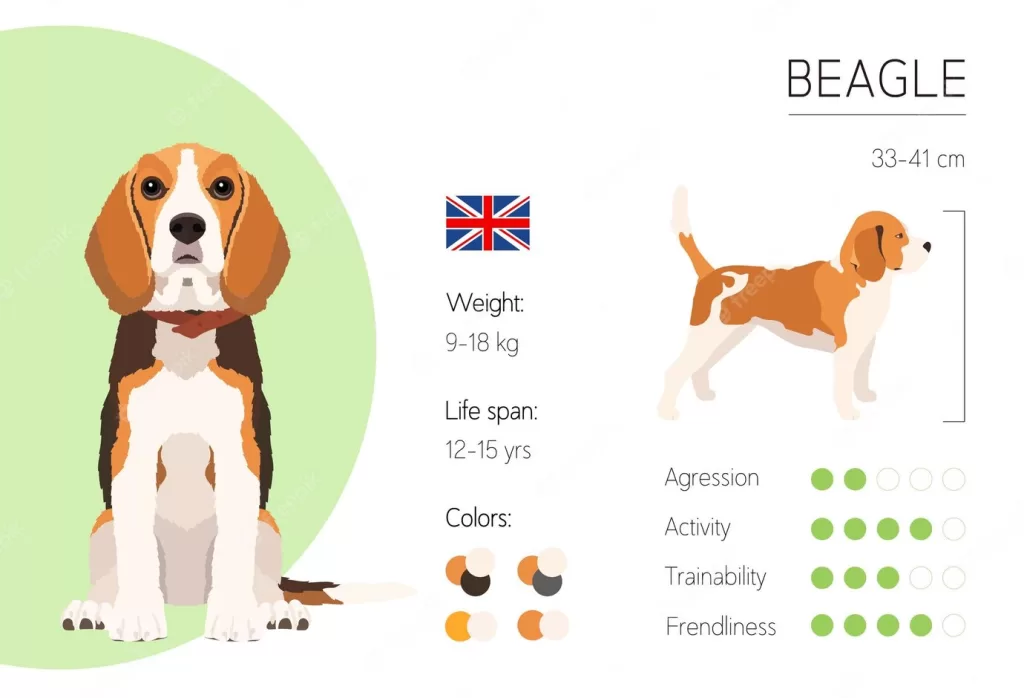Beagles, with their energetic physic, soulful eyes and boundless stamina, have a special place in the hearts of dog lovers. But if you are a Beagle parent, you’ve likely wondered: How long do Beagles live, and what can I do to ensure my dog stays healthy and live long?
Table of Contents
Also Read: 10 Least Aggressive Dog Breeds in the World
Before we jump into conclusions, we must first understand certain things related to beagles like generally what is the average lifespan of beagle and how active is beagle compared with other dogs and what factors will keep the dog healthier and live longer.

The average Beagle lifespan ranges between 12 to 15 years, with some defying the odds to live into their late teens—or even longer. It doesn’t mean that your beagle may expire after 15 years, this is purely an average taken from 100s of dogs life span.
Take Butch, a Beagle from Virginia, USA, who lived an extraordinary lifespan of approximately 27 to 28 years, making him one of the longest-living dogs ever recorded and the longest-living Beagle on record.
Born in 1975 and passing away in 2003, Butch once held the Guinness Book of World Records title for the oldest living dog.

Butch’s remarkable longevity stands out because the average Beagle lifespan is typically between 10 and 15 years, with most Beagles living up to 12-17 years under good care. His long life is attributed to a combination of good genetics, a healthy and active lifestyle, and likely attentive care from his owners, although detailed specifics about his daily routine or health management are scarce.
In this guide, we’ll explore the factors shaping a Beagle’s lifespan, from genetics to lifestyle, and share actionable tips to help your pup thrive. Along the way, I’ll sprinkle in personal stories from my decade-long journey raising Beagles, including how I navigated common health hurdles. Let’s dive in!
Understanding the Beagle Lifespan

Understanding the dog (beagle) life span is not a great rocket science, there are certain conditions that are taken into consideration for determining the life span of the dog. Lets look at those now.
Average Lifespan and Exceptional Cases
Most Beagles live 12–15 years, a lifespan influenced by their small-to-medium size. Smaller breeds often outlive larger ones—Great Danes, for example, average 7–10 years—thanks to slower metabolic rates and reduced strain on organs. But outliers like Butch remind us that exceptional care can make a world of difference.
Also Read: 4 Best Dog Play Pens for Indoor Use in 2025
My own Beagle, Charlie, lived to 16. While he slowed down in his later years, his vitality was a testament to proactive care. Regular vet visits, a balanced diet, and daily adventures kept his tail wagging well into his golden years.
Why Size Matters: The Link Between Breed Size and Longevity

Beagles weigh 20–30 pounds and stand around 13–15 inches tall, placing them in a “sweet spot” for longevity. Research from the American Kennel Club (AKC) shows smaller breeds often live longer due to lower risks of obesity-related diseases and joint stress. However, their curious nature and love of exploration can expose them to accidents—something we’ll tackle later.
Factors That Influence a Beagle’s Lifespan
Genetics and Responsible Breeding
A Beagle’s genetic blueprint sets the stage for their health. Reputable breeders screen for hereditary conditions like hip dysplasia and epilepsy, reducing risks for future generations. Always ask breeders for health clearances from organizations like the Orthopedic Foundation for Animals (OFA).
Sadly, puppy mills and backyard breeders often skip these steps. My friend adopted a Beagle with chronic hip issues traced to poor breeding—a stark reminder to choose breeders wisely.
Common Health Challenges in Beagles
Beagles are generally hardy, but they’re prone to specific health issues:

- Cancer: The leading cause of death in older Beagles, with lymphoma and mast cell tumors being common. Early detection through regular vet checks is critical.
- Epilepsy: Beagles are at higher risk for seizures, often starting between ages 2–5. Medication can manage symptoms, as seen in my neighbor’s Beagle, Luna, who thrives on a tailored treatment plan.
- Ear Infections: Those iconic floppy ears trap moisture, creating a haven for bacteria. Weekly cleaning with a vet-approved solution can prevent infections.
- Obesity: Beagles are food-driven—mine once swiped a loaf of bread off the counter! Obesity shortens lifespan and exacerbates joint issues.
- Hypothyroidism: Symptoms like weight gain and lethargy signal this thyroid disorder, manageable with daily medication.
- Intervertebral Disc Disease (IVDD): Their long backs make them prone to spinal issues. Avoid letting them jump off high furniture to reduce risk.
- Other Issues: Hip dysplasia, cherry eye, and allergies round out the list.
How to Maximize Your Beagle’s Lifespan
Nutrition: Fueling a Long, Healthy Life
A balanced diet is non-negotiable. Choose high-quality kibble rich in protein, like Orijen Original, and avoid fillers like corn. Measure portions to prevent overfeeding—Beagles will eat anything, anytime!
Pro Tip: Use puzzle feeders to slow down mealtime. My Beagle’s obsession with his Kong Wobbler keeps him mentally stimulated and prevents bloat.
Exercise: Keeping Your Beagle Active and Happy
Beagles need 60+ minutes of daily exercise. Walks, sniffing games, and agility training keep them fit. A study by the University of Liverpool found active dogs have lower rates of obesity and anxiety.
Veterinary Care: Prevention Is Key
Routine check-ups catch issues early. Vaccinations, dental cleanings, and parasite control are essential. My vet’s tip: Schedule bloodwork annually after age 7 to monitor organ health.
The Role of Spaying/Neutering
Spaying/neutering reduces risks of mammary tumors and pyometra in females. The ASPCA recommends the procedure at 6–9 months, though consult your vet for timing.
Safety First: Preventing Accidents and Injuries
Beagles follow their noses—into traffic, trash, or toxic plants. Secure your yard, leash them outdoors, and pet-proof your home. A GPS collar, like the Fi Series 3, adds peace of mind.
Key Takeaways at a Glance
| Aspect | Details |
| Average Lifespan | 12–15 years (some surpass 15 with exceptional care) |
| Top Health Concerns | Cancer, epilepsy, ear infections, obesity, IVDD |
| Diet Tips | High-protein food, portion control, avoid human snacks |
| Exercise Needs | 60+ minutes daily; mental stimulation is key |
| Preventive Care | Regular vet visits, dental cleanings, spay/neuter |
Conclusion: Helping Your Beagle Live Their Best Life
While genetics set the baseline, your care determines whether your Beagle reaches—or exceeds—their lifespan potential. From nutrition to safety measures, every choice matters. Reflecting on Charlie’s 16-year journey, I’m reminded that patience, vigilance, and lots of love make all the difference.

